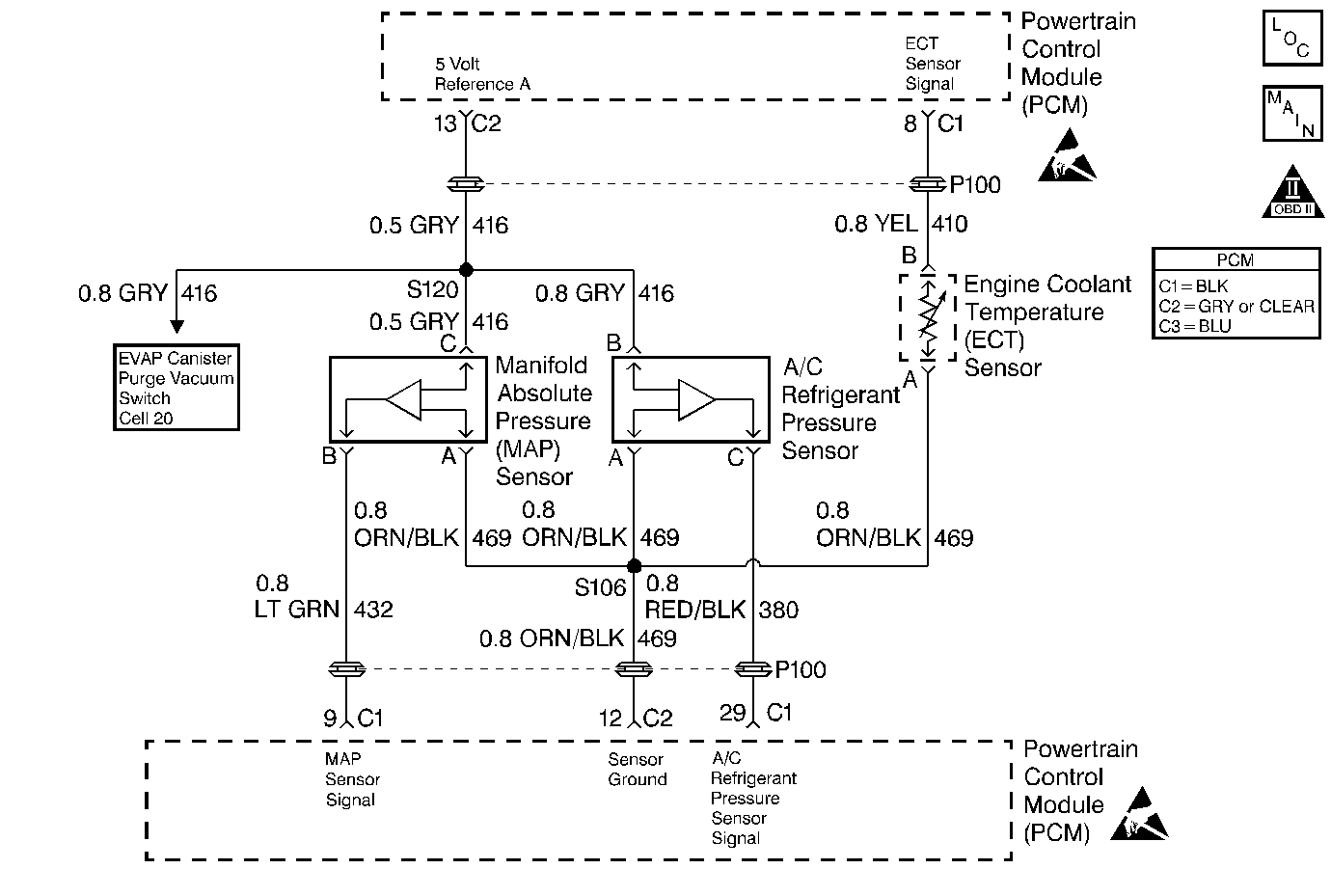
Circuit Description
The Powertrain Control Module (PCM) uses the manifold absolute pressure (MAP) sensor to control the fuel delivery and the ignition timing. The MAP sensor measures the changes in the intake manifold pressure which results from engine load, or intake manifold vacuum, and the RPM changes, and converts these into voltage outputs. The Powertrain Control Module (PCM) sends a 5 volt reference voltage to the MAP sensor. As the manifold pressure changes, the output voltage of the MAP sensor also changes. By monitoring the MAP sensor output voltage, the PCM knows the manifold pressure. A lower pressure, or low voltage, output voltage will be approximately 1.0 to 1.5 volts at idle. Higher pressures, or higher voltage, output voltage will be approximately 4.5 to 4.8 volts at wide open throttle (WOT). The MAP sensor is also used to measure barometric pressure, allowing the PCM to make adjustments for different altitudes.
Conditions for Setting the DTC
| • | MAP is less than 14 kPa. |
| • | Engine speed is less than 1200 RPM. |
| OR |
| • | Throttle Position (TP) is greater than 15% and engine speed is greater than 1200 RPM. |
| • | Above conditions met for 0.2 seconds. |
| • | DTC P0122 or P0123 not set. |
Action Taken When the DTC Sets
| • | The Malfunction Indicator Lamp (MIL) will illuminate. |
| • | The Powertrain Control Module (PCM) will record operating conditions at the time the diagnostic fails. This information will be stored in the Freeze Frame and Failure Records buffers. |
| • | A history DTC is stored. |
| • | Coolant fan turns ON. |
| • | The PCM will substitute a fixed MAP value and use Throttle Position (TP) to control the fuel delivery (scan tool will not show defaulted value.) |
| • | The vehicle will operate in Open Loop when the vehicle is under 8 km/h (5 mph). The vehicle will operate in Closed Loop when the vehicle is over 8 km/h (5 mph). |
Conditions for Clearing the MIL/DTC
| • | The MIL will turn OFF after three consecutive ignition cycles in which the diagnostic runs without a fault. |
| • | A history DTC will clear after 40 consecutive warm-up cycles without a fault. |
| • | The MIL/DTCs can be cleared by using the scan tool. |
Diagnostic Aids
Important: After repairs use the scan tool Fuel Trim Reset function to reset long term fuel trim to 128 (0 %).
With the ignition ON and the engine stopped, the manifold pressure is equal to atmospheric pressure and the signal voltage will be high. This information is used by the PCM as an indication of vehicle altitude. Comparison of this reading with a known good vehicle with the same sensor is a good way to check the accuracy of a suspect sensor. Readings should be the same ± .4 volt.
If a DTC P0107 is intermittent, refer to Symptoms or to Manifold Absolute Pressure Sensor Output Diagnosis for further diagnosis.
Test Description
Number(s) below refer to the step number(s) on the Diagnostic Table.
-
The Powertrain OBD System Check prompts the technician to complete some basic checks and store the freeze frame and failure records data on the scan tool if applicable. This creates an electronic copy of the data taken when the fault occurred. The information is then stored in the scan tool for later reference.
-
This step determines if DTC P0107 is the result of a hard failure or an intermittent condition.
-
Jumpering harness terminals B to C (signal circuit to 5 volts) will determine if the sensor is at fault or if there is a problem with the PCM or wiring.
-
The scan tool may not display 5 volts. The important thing is that the PCM recognizes the voltage as more than 4 volts, indicating that the PCM and CKT 432 are OK. A test light that illuminates indicates a short to ground in the signal circuit.
-
An open or short to ground in CKT 416 could also set additional DTCs.
Step | Action | Value(s) | Yes | No | ||||||
|---|---|---|---|---|---|---|---|---|---|---|
Was the Powertrain On-Board Diagnostic (OBD) System Check performed? | -- | |||||||||
With the engine idling, install a scan tool. Does the scan tool display MAP voltage below the specified value? | 0.25 V | |||||||||
Does the MAP voltage read more than the specified value? | 4.7 V | |||||||||
4 |
Does the scan tool display MAP voltage below the specified value? | .25 V | Go to Diagnostic Aids | |||||||
5 | Inspect the PCM electrical connector terminals for the following conditions:
Was a problem found? | -- | ||||||||
Does the scan tool read over the specified value? | 4.0 V | |||||||||
Check the MAP sensor 5 volt reference circuit for an open or short to ground. Was a problem found? | -- | |||||||||
8 | Repair the connection terminal(s) as necessary. Is the action complete? | -- | -- | |||||||
9 | Replace the MAP sensor. Is the action complete? | -- | -- | |||||||
10 | Repair the MAP sensor 5 volt reference circuit. Is the action complete? | -- | -- | |||||||
11 | Replace the PCM. Is the action complete? | -- | -- | |||||||
12 | Check the MAP sensor signal circuit for the following conditions:
Was a problem found? | -- | ||||||||
13 | Repair the MAP sensor signal circuit. Is the action complete? | -- | -- | |||||||
14 |
Does the scan tool indicate that this diagnostic ran and passed? | -- | ||||||||
15 | Check if any additional DTCs are set. Are any DTCs displayed that have not been diagnosed? | -- | Go to applicable DTC table | System OK |
